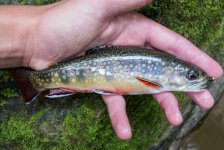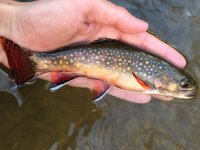Millsertime wrote:
I'm not saying they aren't the same fish but what are you looking at to make that determination and more importantly how many fishermen routinely compare marks on fish they photograph to see if it's a repeat fish?
The two pictures above are definitely the same fish, 100% certainty. Look at the spot pattern. The coloration of a fish can change over time, but its spot pattern is like a fingerprint. Just a few of the things I compared to come to that conclusion:
1. The top two rows of red spots are perfectly parallel and in the same orientation in both pictures. This is somewhat unique and stands out to me. There is one single red spot in between those two parallel rows, just above the lateral line and about in the middle of the fish length wise.
2. Line of four red spots lower on the fish starting just behind the pectoral fin and angling slightly upward as you move back.
3. Yellow spot with an odd red marking in it, below the adipose fin.
I compare my photos a good bit. I’m not sure exactly, but I’ll bet I have a total of 10 or so fish that I know I’ve caught twice, or I’ve caught once and someone has caught once. I’ve even recognized a few fish from posts on PAFF. All were within the same stream the second time as they were the first…most actually in the same very spot, but a few moved…up to a few hundred yards in one case.
When I download my photos after an outing, I put them into a folder with all my other photos from that stream. I usually take a minute to compare any of the memorable fish to fish from prior outings to see if any are a match. My guess is there’s some in my photo folders that I’ve caught twice, and haven’t even identified as such. I think this likely happens way more than we realize. I usually try to take pictures of my fish all in the same orientation, holding them in my left hand (right hand operating the camera – I’m right handed) with their tail toward my wrist and head toward my fingertips. This ensures I get a picture of the same side of the fish each time.








